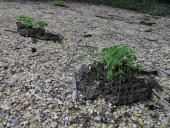posted 12 years ago
Where you based Pam?
A friend recently sent me this article.... http://bhutanobserver.bt/5090-bo-news-about-farmers_discover_monkey_repellent_grass.aspx
I am going to post the article too cos so often I click on links and they no longer working. I have been trying to order some of this seed but unsuccessful to date. It would only be suitable around a field and not for gardens close to the house though.
Farmers discover monkey repellent grass
Molasses grass discovered to be an effective deterrent to monkeys
Maan: Tashi Jamtsho, a former tshokpa of Maan village in Pemagatshel, is all smiles these days. He has found a way to keep marauding monkeys at bay. For the last two seasons, he has reaped bountiful maize harvests. The monkeys and langurs which destroyed his crop in the past haven’t returned after he planted molasses grass (melinis minutiflora) on the fringes of his field. “It is the most effective deterrent to the marauding primates,” Tashi Jamtsho says. In the past, Maan, a village on the edge of a forest, had to fight tough battles against monkeys that destroyed their food crops each year. But the accidental discovery of the animal’s inability to negotiate their way out of the sticky molasses grass tussocks has come as a blessing to some of the farmers in the village. And for the last two harvests, animals like monkeys and langurs spared their maize crops. Last year, Tashi Jamtsho chased away a troop of monkeys from his field. To his surprise, some of the monkeys got struck in the molasses grass tufts and could not flee. He kicked a few and caught some. Thereafter, the animals never came back. Molasses grass is a sticky, tufted, stoloniferous, perennial grass which grows up to a height of 180 cm. It has a strong characteristic odour of molasses or cumin due to the secretion of a volatile oil through the leaf hairs. It grows in thick carpets because of its pioneering growth habit, which together with the secretion, makes animal’s movement in it difficult. The secretion is also known to be effective in preventing tick infestation on cattle. According to Tashi Jamtsho, others in his village have also caught monkeys that got struck in the grass. Thereafter, the primates never returned to the village. He said that earlier, monkeys returned to the fields as soon as the farmers turned their back to them. Tashi Jamtsho and a few other farmers from the village are the registered seed growers for the grass. They grow their grass to full maturity. “If the grass is not grown to its full height, it would not be an effective deterrent,” Tashi Jamtsho said. “In Shali village too, there are reports of less wild animal depredation of crops where fields are fringed with molasses grass,” said Sonam Dorji from Gamong village. He said he is planning to sow molasses grass around his field as a repellent against wild animals. He added that even wild boars could be trapped in the thick sticky grass. While people in Maan village breathe a sigh of relief, there are reports of increased incidences of crop depredation by monkeys in the adjacent villages. It is obvious that the animals are invading new territories. Ap Kunga, a farmer, said he also saw less destruction of crops in his field when it was surrounded by molasses grass. But after he removed the grass to convert the area into an orchard, the attack increased. He later left his field fallow when the attack intensified. Is the solution to the farmer’s woes finally in sight? For now, this grass, introduced in Bhutan through India, has provided some relief to the farmers in more ways than the one intended. But its effectiveness in the long run could only be ascertained after a study. The grass was reportedly introduced in the dzongkhag in the 1980s as part of the livestock department’s effort to promote livestock. This grass continues to be promoted by the government to this day. And it is from here that the seeds of some species of grasses, including that of molasses grass, are being collected for distribution to other dzongkhags. This grass is considered a pioneer grass species which can withstand long periods of dry weather and poor soil. It is also considered to be useful in preventing soil erosion caused by surface runoff because of its rapid growth. However, it cannot withstand overgrazing. By Gyembo Namgyal

















 1
1




 1
1












 1
1




 2
2




 1
1




 1
1









